Book contents
- Frontmatter
- Contents
- Preface
- 1 Introduction
- 2 Formal perturbation theory
- 3 Second quantization
- 4 Diagrammatic notation
- 5 Diagrammatic expansions for perturbation theory
- 6 Proof of the linked-diagram theorem
- 7 Computational aspects of MBPT
- 8 Open-shell and quasidegenerate perturbation theory
- 9 Foundations of coupled-cluster theory
- 10 Systematic derivation of the coupled-cluster equations
- 11 Calculation of properties in coupled-cluster theory
- 12 Additional aspects of coupled-cluster theory
- 13 The equation-of-motion coupled-cluster method for excited, ionized and electron-attached states
- 14 Multireference coupled-cluster methods
- References
- Author index
- Subject index
12 - Additional aspects of coupled-cluster theory
Published online by Cambridge University Press: 06 January 2010
- Frontmatter
- Contents
- Preface
- 1 Introduction
- 2 Formal perturbation theory
- 3 Second quantization
- 4 Diagrammatic notation
- 5 Diagrammatic expansions for perturbation theory
- 6 Proof of the linked-diagram theorem
- 7 Computational aspects of MBPT
- 8 Open-shell and quasidegenerate perturbation theory
- 9 Foundations of coupled-cluster theory
- 10 Systematic derivation of the coupled-cluster equations
- 11 Calculation of properties in coupled-cluster theory
- 12 Additional aspects of coupled-cluster theory
- 13 The equation-of-motion coupled-cluster method for excited, ionized and electron-attached states
- 14 Multireference coupled-cluster methods
- References
- Author index
- Subject index
Summary
This chapter addresses several more subtle but nevertheless important aspects of coupled-cluster MBPT theory.
Spin summations and computational considerations
The formalism described in the previous sections was presented in terms of spinorbitals, without regard to integration over spin coordinates. Even in the case of unrestricted Hartree–Fock (UHF) reference functions, in which the spatial orbitals for α and β spin are different, integration over spin is absolutely necessary to eliminate many integrals and to allow the introduction of constraints over the summation indices, achieving a computational effort of no more than three times that of comparable RHF calculations. Furthermore, all amplitudes in which the number of α and β spinorbitals is different for the hole and particle indices vanish, preserving the MS, but not the S, quantum number. In the restricted closed-shell Hartree–Fock (RHF) case, spin integration is used to combine contributions from α and β spinorbitals, deriving expressions in terms of spatial orbitals only and thus reducing the range of all indices by about a factor 2 (see Section 7.3). Restricted open-shell Hartree–Fock (ROHF) calculations are usually performed as UHF, despite double occupancy, because the most effective algorithms are still of the spin-integrated, spatial-orbital, form. The double occupancy cannot be exploited further without special effort.
The incorporation of spin integration can be done algebraically or, in some cases, diagrammatically. As an example of the diagrammatic treatment of spin summation in coupled-cluster calculations we shall consider the case of the CCD equation with an RHF reference function. The diagrammatic representation of this equation in a spinorbital basis was given in Fig. 9.2 in terms of antisymmetrized Goldstone diagrams.
Information
- Type
- Chapter
- Information
- Many-Body Methods in Chemistry and PhysicsMBPT and Coupled-Cluster Theory, pp. 406 - 430Publisher: Cambridge University PressPrint publication year: 2009
